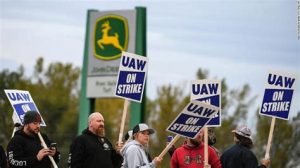We are facing a labor crisis in the United States. Precipitated by the pandemic-induced labor shortage, companies are struggling to find willing employees. In Denver recently, a job fair planned for 5,000 at a Denver airport drew a meager 100 participants. There is a massive shortage of qualified veterinarian surgical staff, a dynamic set in motion by the increased demand for pets during the initial phase of the COVID-19 lockdown.
The labor shortage is especially acute in the agricultural and manufacturing industries. “John Holevoet, director of governmental affairs at Edge Dairy Farmers Cooperative states, “We saw labor shortages expand farm labor to other areas of agribusiness and food processing to other areas of rural manufacturing. People are having a hard time finding people. We’ve been dealing with this for a long, long time.”
The labor shortage in the restaurant sector is also particularly problematic, as there are still 1 million jobs short from reaching its pre-pandemic level of 12.3 million.
All across the United States (and the world for that matter), we are facing an unprecedented schism between employers’ offerings and potential employee responses. In fact, the share of people working or actively looking for work (the labor force participation rate) has dropped to 61.6 percent,” even as “job openings have increased 62 percent” as reported by U.C. Berkeley.
Consequently, businesses face a decision: raise wages, which potentially cuts profits and reduces competitiveness by increasing cost margins, or risk going under because you cannot staff your company, also likely leading to closure. For better or worse, the pandemic has hit a reset button on the American economy, particularly with regard to the needs of workers.
Applicants are simply either not showing up job interviews, or worse still, they are quitting in droves. In August alone, a “record-breaking 4.3 million laborers voluntarily quit, swaths more decided not to resign for better opportunities elsewhere—but to strike for them at their current jobs,” Time magazine reported.
There is a fledgling labor movement taking place in America, and as a result, unions are mobilizing their members. So vigorous is the movement that the month of Halloween has been dubbed, “Striketober.” As Time magazine points out ”In the first five days of October alone, there were 10 strikes in the U.S., including workers at Kellogg plants in Nebraska, Michigan, Pennsylvania, and Tennessee; school bus drivers in Annapolis, Md.; and janitors at the Denver airport.”
And, according to The Economist, “On October 14th about 10,000 employees of John Deere, a manufacturer of agricultural machinery, walked off the job in five states. More than 20,000 nurses and workers in California and Oregon with Kaiser Permanente, a health-care company, have voted to strike” while other strikes, such as behind-the-scenes film and tv workers narrowly averted a strike by forcing a last-minute deal with employers.
Of course, this nascent labor movement pales in comparison to the strikes from previous decades. In 1971 alone, there were 5,716 strikes. Yet, these strikes did not have a backdrop of a pandemic, a phenomenon that has been a game-changer. Cornell University’s School of Industrial and Labor Relations (ILR) argues, “Given its unprecedented nature, the COVID-19 pandemic has raised critical questions regarding wage and hour laws, employment contracts, and employer obligations.”
And much like the COVID-19 virus, the strikes are contagious. As Yahoo Finance notes, “a Cornell Labor Action Tracker shows that more than 180 strikes have been recorded this year, and over 24,000 workers have walked off the job this month.” This includes expected regions, such as the West Coast, where labor unions have been a traditional stronghold, but also in more employer-friendly states such as Texas and Louisiana, in both public and private sector jobs. Furthermore, The National Federation of Independent Business reported recently that “a record 51% of small-business owners had openings in September that they could not fill, a 48-year high.”
Regardless of the sector, workers are simply not accepting the pre-pandemic status quo. Elizabeth Shuler, President of the AFL-CIO, who filled the huge shoes of former AFL-CIO President Richard Trumka, explains the movement is “the culmination of going through this pandemic, where workers were told they were essential, and now are being treated as expendable,” adding “they’ve sacrificed so much, and then now are faced with takeaways, and a basic lack of respect and recognition.”
From autoworkers to nurses, to hospitality and entertainment workers, people are putting their collective feet down and demanding better wages, working conditions, and a more amenable culture that honors their contributions to the bottom line. The reality is that although this fissure between employers and their employers was exposed by COVID-19, the dynamics have been in the making for decades.

Source: kbhbradio.com
The Economic Policy Institute frames it this way: “There have been countless examples of workers speaking out against unsafe work conditions and demanding personal protective equipment (PPE) to try and stay healthy and safe on the job. We also have seen that essential workers are often not paid commensurate with the critical nature of their work. Few U.S. workers have access to paid sick time or paid leave of any kind. And, when workers have advocated for health and safety protections or wage increase, they have often been retaliated against, and even fired for doing so.”
A recent poll from the job site Monster.com reveals 86% of workers feel that their career has stalled during the pandemic and that 80% feel their current job does not offer the growth they need, either through position advancement or salary increases. Burnout plays a key role in the dissatisfaction of many workers. Insider reports that “61% of Americans felt they were at least somewhat burned out, and more than two-thirds of respondents to an Indeed poll in March said they felt more burnt out since “COVID-19 upended their working life.”
Mayo Clinic cites lack of control, unclear job expectations, dysfunctional workplace dynamics, lack of support from employers, and an out-of-kilter work-life balance as some of the likely reasons workers are experiencing burn-out.
Regardless of the reason, many people have apparently had enough, and are using the pandemic as an opportunity to push back. “We shouldn’t be begging for lunch breaks in 2021. I am 100 percent not financially prepared to go on strike, but we need to course-correct. Right now, it’s an industry I regret even getting into,” said Gina Scarnati, 44, a specialty costume manufacturer with more than 10 years of experience in the sector.
At the end of the day, it is at least partly a leadership problem, because it is the leaders of companies that set policy, and more importantly, create the conditions and culture under which people thrive, or leave. Roberta Matuson, a leadership development and management consultant contends, “If you want to stop the flow of employees exiting your firm, commit to investing in your leaders. Give them the help they need to be what I call a magnetic leader–someone who effortlessly attracts top talent that sticks around.”
Because, unlike previous labor movements, it’s not just about money, it’s about the context and tone of the work environment, especially for those that work remotely. As Forbes writes:
“The emphasis will be placed on creating culture and enhancing healthy engagement among employees to achieve desired business outcomes. We’re social creatures, and work has to get done. Camaraderie plays a big part in that; without physical workspaces, this presents an enormous challenge.”
Meanwhile, President Biden’s commitment to labor is being tested. On one hand, Biden offers himself a champion of the movement, recently stating: “My sole measure of economic success is how working families are doing, whether they have jobs that deliver dignity. That means we have to focus on wages like we used to. When it comes to the economy, rebuilding rising wages aren’t a bug. They’re a feature. We want to get something that economists call full employment. Instead of workers competing with each other for jobs that are scarce, we want employers to compete with each other to attract work.”
On the other hand, he appears to be carefully threading the needle about stikes, saying, “They have a right to strike, and they have a right to demand higher wages, and the companies they’re striking on are doing very well. I’m not going to get into the negotiation, but my message is: If you think that’s what you need, then you should do it.”
Goring forward, how Biden responds, not just with words but with policy actions, will be crucial to both his favorability, which is waning and his electivity, as well as his tail-coat influence on mid-term elections. Currently, Biden is struggling to keep his political head above the water, as recent CNBC All-America Economic Survey as Americans show the public has “soured on his economic leadership, lost some confidence in his handling of the coronavirus, and grew increasingly concerned about inflation and supply shortages.”
But it will be difficult for the President because, underneath the moral dimensions of the labor movement, our economy is at stake. Ariel Avgar, an associate professor of labor relations, law and history at Cornell University asserts:
“This will come at an economic cost to employers and therefore the economy, and I think that may be why Biden has gone a little silent. It is tricky for him. On the one hand, he is on the record supporting unions and their ability to use collective action. On the other hand, the point of strikes is to extract an economic price for employers unwilling to negotiate in a way the union feels is appropriate.”
His lack of commitment has not gone unnoticed. As AOL News reports, “David Schildmeier, a spokesman for the Massachusetts Nurses Association, said he is being asked almost every day by nurses striking outside Saint Vincent Hospital in Worcester, Massachusetts, why Biden hasn’t given his support or whether Vice President Kamala Harris would be willing to come to the picket line.” Such a tepid approach isn’t exactly winning any hearts and minds for the people in the trenches.
Take the case of Marlena Pellegrino, a nurse who has worked at Saint Vincent hospital for 35 years and has been picketing alongside 700 colleagues for more than eight months, many of whom have lost their health insurance benefits and are becoming desperate as the clock ticks.
In reference to Biden’s lukewarm support, Pellegrino declared, “It is time for someone to step up. We would absolutely love and implore the president to get involved. There hasn’t been any direct involvement at that level.” Earlier in the year, a coalition of more than three dozen organizations sent a letter to the White House stating, “One of the most important things a president can do to help working people is to have their backs when they challenge corporate power, providing public support to the idea that Americans have a right to bargain collectively for better working conditions.” Yet, Biden continues to walk the tightrope.
The truth is that the pandemic has exposed the ongoing tension in our economy that pits two narratives against one another: robust employment and low inflation. Eric Levitz of NY Magazine elucidates:
“If unemployment falls beneath its ‘natural’ threshold, then employers will be forced into a bidding war for scarce workers, who will then secure wages in excess of their productivity, which will force businesses to raise prices, which will lead workers to demand yet-higher wages, which will force businesses to raise prices further still, thereby setting off an inflationary spiral that will be difficult to stop. Thus, to save the economy from such destabilization, the government has to reduce economic demand — by raising interest rates, or cutting federal spending, or both — before unemployment gets too low, even if inflation is not yet apparent.”
This is likely why our federal government has been downplaying the recent spike in inflation. In other words, ironically, by supporting the labor movement through policies such as government assistance via money printing, unnaturally low interest rates, and pushing for collective bargaining, the government helps the worker by creating scarcity, thus improving workers’ leverage in the labor market. However, long term, this will lead to inflation, which will erode purchasing power and ultimately negate the economic gains.
Nonetheless, things are not likely to go back to the way they were before, something that is in favor of people looking to expand their opportunities and awards in the workplace.






